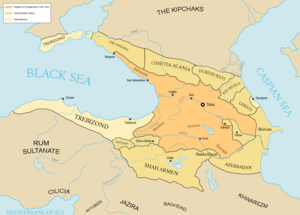Georgian military campaigns over Armenian lands
| Georgian military campaign over Armenia | |||||||
|---|---|---|---|---|---|---|---|
| Part of Georgian–Seljuk wars, Georgian-Ayyubid wars | |||||||
 Kingdom of Georgia in 1184-1230 at the peak of its might | |||||||
| |||||||
| Belligerents | |||||||
|
| |||||||
| Commanders and leaders | |||||||
|
David Soslan Ivane Mkhargrdzeli Shalva of Akhaltsikhe |
| ||||||
| Strength | |||||||
| 25,000 | 60,000 | ||||||
A number of wars between the Kingdom of Georgia and various Muslim states over the Armenian lands in eastern Anatolia, fought from c. 1198 until 1209. This brought the struggle for the Armenian lands to a stall,[1] leaving the Lake Van region in a relatively secure possession of its new masters – the Ayyubids of Damascus.[2]
History[edit]
The question of Armenia remained of prime importance in Georgia's foreign policy. At the beginning of the 13th century Georgian armies under the command of Mkhargrdzeli brothers overran fortresses and cities towards the Ararat Plain, taking Gelakun (near Sevan), Bjni, Amberd and all the towns on their way. In 1199 Georgians finally gained control over the town of Ani, the former capital of Bagratid Armenia, and Tamar gave the governorship of the city to her High Constable Zakaria II Mkhargrdzeli and Ivane Mkhargrdzeli.
The Georgian victories alarmed all the neighbouring Muslim rulers, particularly Rukn ad-Din Süleymanshah II, sultan of Rum, a Seljuk kingdom in Asia Minor. Rukn ad-Din came with his troops from Damascus and Aleppo to conquer her kingdom. The Georgians met them at Basiani, and put them to flight. Loss of the sultan's banner to the Georgians resulted in a panic within the Seljuq ranks. Süleymanshah himself was wounded and withdrew to Erzurum. A huge amount of booty was captured, and the many prisoners included the emir of Erzincan, an ally of the sultan. The victory at Basian secured the Georgian preeminence in the region. Exploiting her success in this battle, Georgians seized the town of Dvin In 1203 and subdued the Emirate of Kars, Akhlatshahs, and the emirs of Erzurum and Erzincan. In 1204-1205 the Georgians entered Khlat; twice and occupied much of the Akhlatshah possessions, such as Artchesh, Manazkert and subdued the Emirate of Kars, Akhlatshahs, and the emirs of Erzurum and Erzincan.
The Muslim rulers could not reconcile themselves to these advances and decided to make another concerted attack on Georgia. The ruler of Khlat requested aid from Tuğrulshah, ruler of Arzan ar-Rûm (Erzerum). When the latter's troops arrived, the ruler of Khlat marched against Georgia. The Georgians, who had grown accustomed to victories, underrated the strength of the Akhlatshah, failed to prepare their defences and, as a result, suffered defeat. Many fell victim to this careless attitude to the enemy. The retreating Georgian army left considerable booty to the enemy. In 1205-1206 the Georgian army undertook another campaign with the conquest of Khlat as its objective. It laid waste the territory of the sultanate, collecting booty, but the Muslim forcesagain attacked suddenly, defeated it and seized Khlat. These two humiliating defeats and the occupation of Khlat by the Muslims negatively affected Georgia's international standing.
The situation demanded immediate measures. In 1206 the Georgian army, under the command of David Soslan, captured Kars, the fortresses and strongholds along the Araxes. This campaign was evidently started because the ruler of Erzerum refused to submit to Georgia. The emir of Kars requested aid from the Akhlatshahs, but the latter was unable to respond. The fortress-town of Kars, situated on a major trade-route was a Seljuk stronghold at the approaches to Georgia. For the Seljuks the loss of Kars was as painful as the loss of Ani.
Confrontations with Ayyubids[edit]
In 1207, the Akhlatshah was taken over by the Ayyubids, who had long coveted Khlat. The Ayyubids had come to the city at the invitation of people of Khlat after the last Sökmenli ruler was killed by Tuğrulshah, the ruler of Erzurum on behalf of the Sultanate of Rûm and brother of Sultan Kayqubad I. Before Ayyubid control could be solidified, al-Awhad faced revolts in Artchesh and Van. As he attempted to quash those insurrections, Khlat joined the rebellion later in 1208. Upon the orders of al-Adid, al-Ashraf led an army of roughly 1,000 troops to support al-Awhad and the Ayyubids managed to put down the revolt in Khlat, resulting in a heavy loss of life.[3]
By 1209 the Christian kingdom of Georgia challenged Ayyubid rule in eastern Anatolia and led liberational war for south Armenia. Georgian army invaded the possessions of the Sultan of Khlat. It advanced towards Artchesh and captured the town. It then invested Khlat. In response al-Adil assembled and personally led large muslim army that included the emirs of Homs, Hama and Baalbek as well as contingents from other Ayyubid principalities to back al-Awhad and al-Ashraf. During the siege, Georgian general Ivane Mkhargrdzeli accidentally fell into the hands of the al-Awhad on the outskirts of Akhlat and demanded for his release a thirty-year truce. The Georgians had to lift the siege and conclude peace with the sultan. It was this accident, so typical of al-'Adil's luck, that ended the Georgian menace to Ayyubid Armenia.[4] Georgia refrained from hostilities against enemy with whom Tamar had signed a treaty, and the border or Christian-Muslim world was established.
See also[edit]
References[edit]
- ↑ Lordkipanidze & Hewitt 1987, p. 154
- ↑ Humphreys 1977, pp. 130–131
- ↑ Humphreys, 1977, p. 129.
- ↑ Humphreys, 1977 p. 131.
Sources[edit]
- Mariam Davydovna Lordkipanidze; George B. Hewitt (1987). Georgia in the XI-XII Centuries. Ganatleba Publishers. Search this book on

- R. Stephen Humphreys (1977). From Saladin to the Mongols: The Ayyubids of Damascus, 1193-1260. SUNY Press. ISBN 978-0-87395-263-7. Search this book on

| This Georgian history-related article is a stub. You can help EverybodyWiki by expanding it. |
This article "Georgian military campaigns over Armenian lands" is from Wikipedia. The list of its authors can be seen in its historical and/or the page Edithistory:Georgian military campaigns over Armenian lands. Articles copied from Draft Namespace on Wikipedia could be seen on the Draft Namespace of Wikipedia and not main one.


